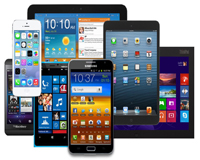Chinese smartphone owners spend nearly eight hours looking at electronic screens each day, the third longest in the world, with smartphones and laptops dominating their "screen time," according to survey results released on Wednesday.

The survey, conducted by market research company Millward Brown, which is part of British advertising giant WPP, polled more than 12,000 smartphone owners in 26 countries and regions around the world.
The survey found that Chinese smartphone owners are increasingly using mobile phones and laptops both in conjunction with and in replacement of TVs.
On average, a Chinese smartphone owner spends 479 minutes looking at the screens of TVs, laptops, smartphones and tablets -- 62 minutes more than global average.
Smartphones (170 minutes per day) and laptops (161 minutes per day) dominate their "screen time," while TV holds their attention for only 89 minutes per day -- one of the shortest among all countries surveyed.
Chinese smartphone owners' time spent in front of TV screens during traditional prime time is also significantly shorter than the global average.
Though 29 percent of respondents watched TV from 6 p.m. to 9 p.m., the same as the global average, only 22 percent were still watching it from 9 p.m. till midnight, 10 percentage points lower than the global average, it said.
The survey found that even when they're in front of a TV, their attention is shared across different screens.
When asked about their reasons for using a second device, 91 percent of respondents said it was to access information unrelated to TV content while watching TV, including to "fill time during ad breaks" (44 percent), "keep up with friends on social media" (42 percent) and "TV not interesting enough" (35 percent). The proportion of people claiming TV content is boring is 7 percentage points higher than the average around the world.
Chinese audiences have increasingly formed a multiscreen lifestyle -- they not only use other devices when watching TV, some of them have even started to shift away from TV to watch television content on mobile phones and tablets, said Chris Maier, Millward Brown's Greater China director for media and digital solutions.
Consumers are utilizing multiple screens for the purpose of "meshing," using different devices to seek information about the same topic, like to further research TV programming content, and "stacking," using different devices to seek content about different topics, according to Maier.
"We see this latter trend as growing evidence that strong programming content online is taking consumers away from TV and more to online TV. Finally, the adage that 'content is king' holds true and, consequently, holistic media shifting is taking place," he said.
However, people do still respond in a positive way to interesting TV content, Maier pointed out, citing the fact that 25 percent of respondents said they will use a second device to "learn more information about what's on TV" while 18 percent said they will "discuss what I'm watching via social media."
"This shows that TV audiences' multiscreen behavior is dynamic: they either seek entertainment elsewhere, away from TV content, or pour more attention into the interesting shows," he added.
These new findings should encourage marketers to design and execute more integrated marketing campaigns across multiple screens.
"Since Chinese people are spending so much time across screens, marketers have to make sure their message is consistent regardless of channels," according to Maier.
By the end of 2013, 500 million Chinese were accessing the Internet via mobile phones, accounting for 81 percent of the country's netizen population, figures from China Internet Network Information Center showed.





